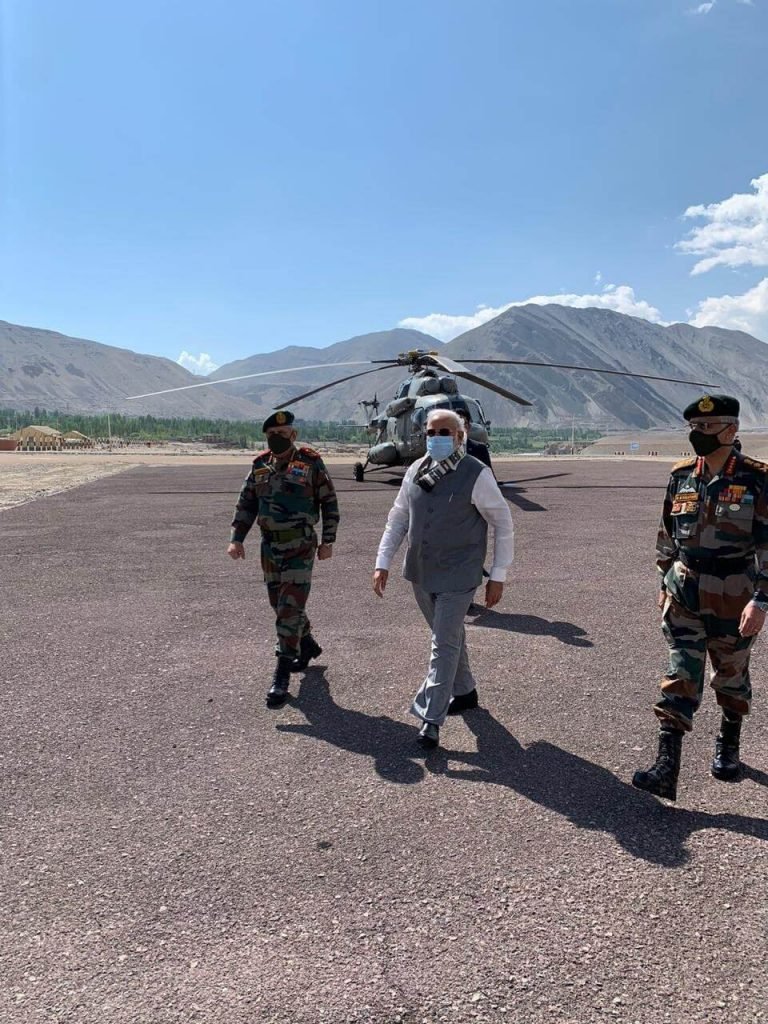Accompanied by the Chief of Defence Staff General Bipin Rawat and Army Chief Gen MM Naravane, Prime Minister Narendra Modi on Friday landed in Leh on Friday morning on a closely-guarded visit to the union territory that has been at the center of the standoff with China’s People’s Liberation Army troops since early May.
Top government officials had earlier only let it be known that CDS Rawat would visit Ladakh for a review of the tri-services preparedness and a first-hand understanding of the proposed de-escalation and disengagement process at the four stand-off points. It was only after PM Modi emerged from the plane that news of PM Modi’s surprise visit got out.

PM Modi’s visit to the border area is high on symbolism, and a morale booster for the troops that are leading the stand-off in Ladakh’s Galwan valley and around Pangong lake.
He was briefed by the Northern Army Commander Lt Gen Y K Joshi and XIV Corps Commander Lt Gen Harinder Singh at Nimu Army headquarters near Leh.
Located at 11,000 feet, this is among the tough terrains, surrounded by Zanskar range and on the banks of the Indus.
PM Modi will also address soldiers at Thiksey near Leh and visit the soldiers injured in the June 15 violent scrap with China’s People’s Liberation Army.
Although the Ministry of External Affairs spokesman on Thursday called for expeditious dis-engagement from the border, the de-escalation process will take time with the PLA not in the mood to walk the talk between the two governments on ground.
Despite talking about peace and dis-engagement, the PLA troop withdrawal from Galwan, Gogra, Hot Springs and Pangong Tso will take a lot of time and serious persuasion.
According to military commanders, the PLA continues to earmark its territory at all the stand-off points by physical deployment while undertaking superficial thinning in the rear by withdrawing a few vehicles and few men.
The PLA stands amassed at Galwan River Valley and consolidated at Pangong Tso with massive infrastructure upgrade.
Faced with a recalcitrant adversary, the Indian Army and Air Force are fully deployed to prevent any further aggression from the PLA. The morale of the forces appears to be very high particularly after the June 15 flare-up at Galwan.
“ We have no intentions of initiating any skirmish but any aggression from the other side will be fully repelled,” said a senior military commander.
With temperatures in East Ladakh and Tibet well over 20 degree Celsius and high-velocity winds sweeping the region, air operations in the area are a challenge with weight limits being imposed during take-offs, particularly in Russian origin platforms.
While IAF will use the airbases in the plains in the worst-case scenario, the PLA Air Force will have serious difficulty in operating from Tibetan Plateau. The coming days will also be a test of unproven Chinese air platforms, missiles and land systems as their battle worthiness has never been challenged.